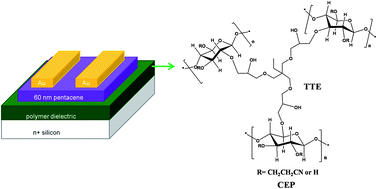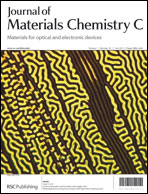Low-voltage operable organic field-effect transistors (OFETs) were fabricated using a low-temperature curable high-k polymer cyanoethyl pullulan (CEP) as a gate insulator with trimethylolpropane triglycidyl ether (TTE) as a crosslinking agent. With this crosslinking agent, the gate insulators showed low leakage current and a high dielectric constant of 14.8–16, and most importantly, could be cured at low temperatures around 100 °C, which is compatible with most plastic substrates for future plastic electronics. The favorable semiconductor–dielectric interface was obtained due to the surface alignment of well-packed pentacene domains, which enabled excellent transistor performance, with one of the highest mobilities around 6 cm2 V−1 s−1, an on/off current ratio (Ion/Ioff) ∼105, and a steep subthreshold (SS) ∼0.095 V dec−1. The high mobility was found to be closely correlated with the surface C![[triple bond, length as m-dash]](https://www.rsc.org/images/entities/char_e002.gif) N dipole density rather than other possibilities, such as dielectric roughness and surface energy. The initial growth of the semiconductors was also studied and correlated with the affecting variables.
N dipole density rather than other possibilities, such as dielectric roughness and surface energy. The initial growth of the semiconductors was also studied and correlated with the affecting variables.

You have access to this article
 Please wait while we load your content...
Something went wrong. Try again?
Please wait while we load your content...
Something went wrong. Try again?
![[triple bond, length as m-dash]](https://www.rsc.org/images/entities/char_e002.gif) N dipole density rather than other possibilities, such as dielectric roughness and surface energy. The initial growth of the semiconductors was also studied and correlated with the affecting variables.
N dipole density rather than other possibilities, such as dielectric roughness and surface energy. The initial growth of the semiconductors was also studied and correlated with the affecting variables.

 Please wait while we load your content...
Please wait while we load your content...